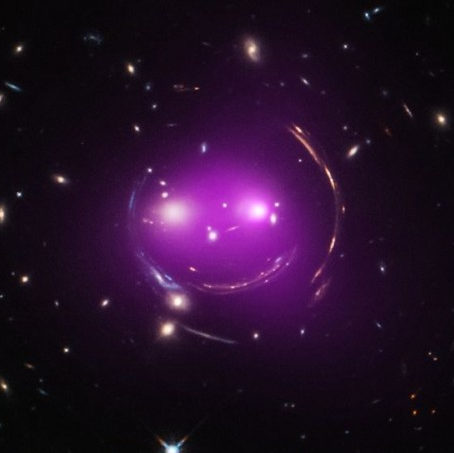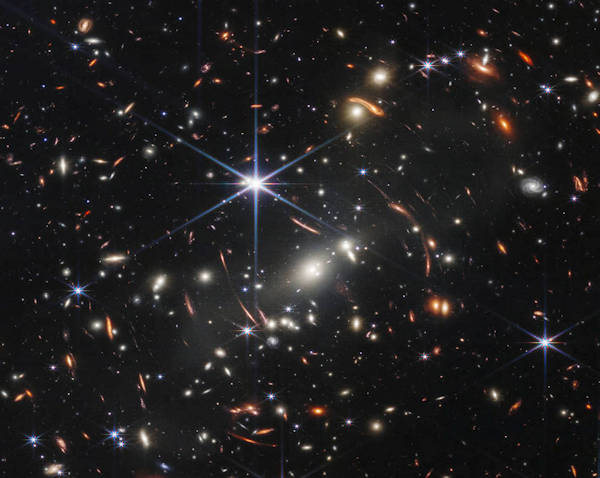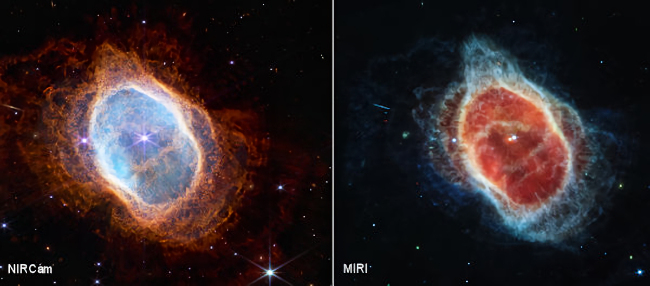On November 23, 2015 the Chandra X-Ray Observatory released the image below, of what’s come to be called the Cheshire Cat Galaxy Group. It is a fun image and is also the subject of scientific research. But it serves as an example of how we human beings look for meaning in things. It reminds people of the Cheshire Cat with its big grin, in the story of Alice in Wonderland. So we associate an astronomical phenomenon with an entertaining fictional story. It has become a popular astronomical image. But more than that it an enjoyable or humorous picture. It has been taken to mean a variety of things by various writers and bloggers. A few days after the Chandra X-Ray Observatory released the image, NASA also released it to celebrate the 100th anniversary of Albert Einstein’s theory of General Relativity. Einstein’s General Relativity theory was first published in November of 1915.
From a naturalistic or atheistic mind set, the universe can seem like an empty harsh place, with no purpose. But if you can accept there being a Creator-God who has made the universe with a purpose for our benefit, that makes it all have more meaning. From the Bible, we find that God has created things for our benefit, to show us His glory and draw us to Him. He wants the universe to stimulate us to ask questions and look to Him. So human beings found this in the sky but it can cause us to wonder about the universe and about the One who made it all. It is something that can be appreciated for both its scientific mysteries and just for enjoyment. There is more to space than just the beauty of nature and the mechanics of how the universe works. In the Good Heavens podcast we try to make things in astronomy meaningful from a Christian perspective.
What is this Image?
First I must explain what the image is. You might suppose in looking at it that it is someone’s prank, that someone made it with a photo editor program and that it wouldn’t actually look like this image if you saw it in space. The image is of two galaxy groups, that have numbers SDSSCGB 8842.3 and SDSSCGB 8842.4. The SDSS label refers to the Sloan Digital Sky Survey, which is a major project to map the entire night sky. But the image is a composite of two images, one in visible light from the Hubble Space Telescope and the other an X-Ray image from the Chandra X-Ray space telescope. So, it is not artificially created at all. It just overlays the X-Ray image over the optical visible light image from the Hubble telescope. One “artificial” thing is that X-Rays are not visible to the naked eye, so they are artificially colored purple in the image to make the invisible light visible. To see it in space you would find it in the constellation of Ursa Major, the Big Dipper. If you could see it with the naked eye it would look like the Hubble image. But you’d need a big telescope and a long exposure to capture it. The Chandra X-Ray image used a 19.5 hour exposure time.
The next question is what is it a picture of? The bright objects in the image are not stars but galaxies. Two bright large galaxies make the two eyes of the cat, another makes the nose at just the right place, and you see streaks that make a roughly circular “boundary” that give the outline of the cat’s face. Scientifically it is caused by the two large galaxies (and smaller galaxies with them) that are moving at high speed toward colliding. (The two large galaxies are careening toward each other at about 1,350 km per second. This is about 3 million miles per hour!) There are very hot gases between and surrounding the galaxies that are heated to millions of degrees in temperature. These hot gases are giving off the X-Rays that make the purple color.
Another thing that makes the image well-known and interesting is that it is an example of gravitational lensing. The galaxies in this group are very massive. When you have a massive object or cluster like this and there are other galaxies directly behind it much farther out, the far galaxies light can be bent and distorted by the mass of the massive cluster nearer to us. This creates the streaks that seem to make a rough circle around the “face” of the cat. The galaxies far behind could not be seen without the gravitational lensing effect because they would be along our line of sight behind the cluster we see. There are a number of interesting examples of light bending around massive objects in space like this. Einstein predicted that gravity could bend light in this way even before 1915. Einstein’s theories on gravity have been confirmed in many experiments. Some people have difficulty believing in some of Einstein’s ideas but they have been confirmed over and over. They show that God has made the universe an amazing place that stretches our ability to understand. Einstein’s General Relativity concepts are not about the origin of the universe, they are about how masses and light really behave today in the universe. So this makes gravitational lensing part of experimental science, which we can usually trust. It is in the science of origins where we must be more careful about what we believe.
The Cheshire Cat grin in space has led to many interesting reactions and comments. One webpage showing the picture called it “Alice in Wonderland Meets Albert Einstein.” Another interesting website was that of an artist, Alexandra S. Badiu. She had a page of artwork that sort of puts Alice in Wonderland in an outer space context or with aliens (click here to see) Of course, I would believe God made the galaxy cluster that appears to make the “face” and God made X-Rays possible from it, but that doesn’t mean God somehow inhabits it. God is outside of the universe, not a part of it. Also, the Bible is clear that people should not worship anything seen in outer space because it is all created things. But a smiley face in space is very suggestive to us and stimulates our imagination. Imagination and science are probably more closely related than we usually realize. Appreciating the mathematical or scientific aspects of something in space should not keep us from enjoying something just because it is beautiful or entertaining. In the Good Heavens podcast we try to appreciate multiple aspects of astronomical phenomena and relate it to our faith. Brian May once said, “astronomy’s much more fun when you’re not an astronomer.” (He was a guitarist in the rock group “Queen” but he also had a degree in astrophysics.) But astronomers can also grin at the wonders of the universe.
Mysteries Behind the Grin
The Cheshire Cat galaxy group is technically what’s known by astronomers as a “fossil group progenitor.” A fossil galaxy group is believed to have one large galaxy that is significantly brighter than all the other galaxies near it in the group, and it gives off a lot of X-Rays. This group of galaxies does not qualify as a fossil group yet, but in about one billion years if the two eye galaxies merge together, then it would.
So, what astronomers think happened to this cluster is that small galaxies around the two bright eye galaxies have been spiraling inward making the two large galaxies even bigger. But the “fossil” term means that once the large elliptical galaxy in the center merges, then the cluster would essentially stay the same for a very long time while the gases heated up in the collision give off X-Rays. But there are mysteries about galaxy clusters like this. First, it is believed there must be a great deal of dark matter in these clusters in order to explain how they can cause so much gravitational lensing. So, galaxy clusters are often considered a good argument for the existence of dark matter. However, some fossil galaxy groups even do so much gravitational lensing that even dark matter models don’t provide enough mass to explain them. Another mystery comes up with their origin. From models of the formation of these clusters, in some cases even in the accepted age of the universe (about 13.8 billion years) they would not have time to form. The high temperature of the gases is sometimes a mystery also. These clusters are thought to be very old but in billions of years the gases should cool. So scientists would like to answer some questions about fossil galaxy groups.
In 1969, mankind from planet Earth landed men on the Moon and returned them safely home. That was a great accomplishment. It was an accomplishment which God was not left out of because of the faith of several of the astronauts, prayers for the Apollo program from people on Earth, and many fortuitous events that made success possible along the way. Good Heavens podcasts have shown this to be true in multiple podcasts including interviewing astronaut Charley Duke. But it took many more space accomplishments before mankind could get the Cheshire Cat image. Engineers had to create the Hubble Space Telescope, get it into Earth orbit, and then repair it in order to get the optical image that shows the galaxies and the lensing effect. Then scientists had to get the Chandra X-Ray Observatory telescope in space in order to get the X-Ray image of the same galaxy cluster. How fortunate we have been that God has allowed us to accomplish these things! But mankind still has many problems and needs God’s forgiveness and grace. I think Psalm 8:1, 3-4 would be appropriate to end with:
“O Lord, our Lord,
NIV 1984 Bible, Psalm 8:1,3-4.
how majestic is your name in all the earth!
You have set your glory above the heavens.
. . .
When I consider your heavens, the work of your fingers,
the moon and the stars, which you have set in place,
what is man that you are mindful of him,
the son of man that you care for him?
You made him a little lower than the heavenly beings
and crowned him with glory and honor.”





